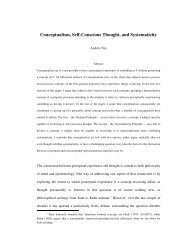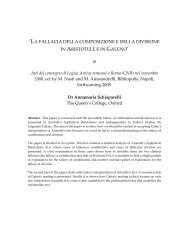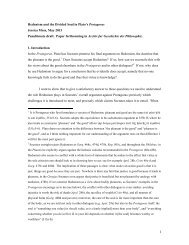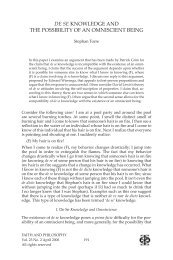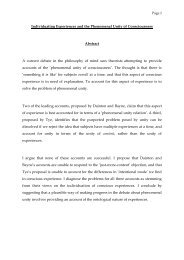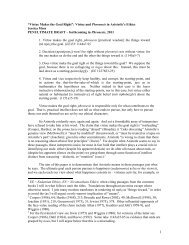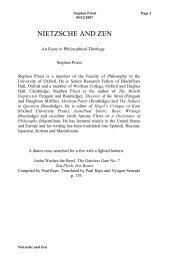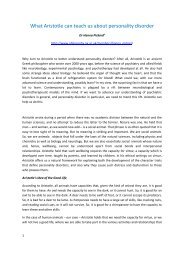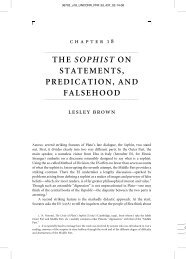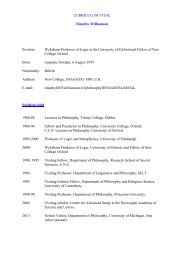Essence and Cause in Plotinus
Essence and Cause in Plotinus
Essence and Cause in Plotinus
You also want an ePaper? Increase the reach of your titles
YUMPU automatically turns print PDFs into web optimized ePapers that Google loves.
dialectic through the method of division reveals what the Forms are, i.e., it reveals their<br />
def<strong>in</strong>ition. The method of division is therefore a suitable c<strong>and</strong>idate for the activity of unfold<strong>in</strong>g<br />
the Forms, for it can reveal the way <strong>in</strong> which each Form is related to the others (<strong>and</strong> hence to the<br />
whole of the <strong>in</strong>telligible world).<br />
Let us focus now our attention to the notion of cause. For, it would be natural to ask<br />
what k<strong>in</strong>d of causal role is to be ascribed to the Forms. Given the complexity of this problem, it<br />
is only possible to draw a map of the suggestions presented <strong>in</strong> some of the texts analysed <strong>in</strong> this<br />
paper. 27 In particular, accord<strong>in</strong>g to our text (2), it is possible to f<strong>in</strong>d the follow<strong>in</strong>g<br />
characterisation of the Forms’ causality. The general idea is that there are (at least) two ways <strong>in</strong><br />
which one can say that Forms are causes. The first is that Forms are causes for sensible items. It<br />
is a possibility that Plot<strong>in</strong>us is here referr<strong>in</strong>g to someth<strong>in</strong>g like the Platonic view that sensible<br />
items partake of Forms: Forms provide the ontological grounds of particulars that partake of<br />
them. But it is more plausible to suspect that Plot<strong>in</strong>us could offer his personal elaboration about<br />
the relationship between Forms <strong>and</strong> sensible items: the essence of a sensible object could be<br />
determ<strong>in</strong>ed by reflection of an <strong>in</strong>telligible Form. 28 If this is correct, then it is <strong>in</strong> this latter sense<br />
that, accord<strong>in</strong>g to Plot<strong>in</strong>us, Forms are the ontological grounds of the particulars. However, given<br />
that it is not Plot<strong>in</strong>us’ primary concern to go <strong>in</strong>to the details of the relationship between Forms<br />
<strong>and</strong> sensible items <strong>in</strong> the last l<strong>in</strong>es of our text (2), we can turn to the second way <strong>in</strong> which Forms<br />
are causes.<br />
This second way <strong>in</strong> which Forms are causes is still difficult to def<strong>in</strong>e. We are deal<strong>in</strong>g<br />
with a different k<strong>in</strong>d of causality, as sensible items are not <strong>in</strong>volved: this is the k<strong>in</strong>d of causality<br />
that one f<strong>in</strong>ds when one unfolds a Form.<br />
When we focus on this second way <strong>in</strong> which Forms are causes, a complex picture<br />
presents itself. For our present purposes, it suffices to del<strong>in</strong>eate only some of its traits. A<br />
characteristic feature of Plot<strong>in</strong>us’ Forms is that they do not depend on other th<strong>in</strong>gs that are not<br />
<strong>in</strong>telligible be<strong>in</strong>gs. Still, at the same time, Forms should not be taken <strong>in</strong> isolation: they are to be<br />
taken <strong>in</strong> their mutual relations (<strong>in</strong> particular <strong>in</strong> their relations with the primary genera) <strong>and</strong><br />
hence <strong>in</strong> their <strong>in</strong>terconnection with the whole of the <strong>in</strong>telligible world. Hence, there is a certa<strong>in</strong><br />
k<strong>in</strong>d of dependence of the Forms on the <strong>in</strong>telligible world. Accord<strong>in</strong>gly, when one comes to<br />
grasp the essence <strong>and</strong> the cause <strong>in</strong> the unfold<strong>in</strong>g of the Form, one underst<strong>and</strong>s what the Form is<br />
by grasp<strong>in</strong>g how it is related to (<strong>and</strong> dependent on) other Forms (<strong>in</strong> particular, the primary<br />
genera). One thereby grasps the connections <strong>and</strong> the <strong>in</strong>terrelations between different elements<br />
of the <strong>in</strong>telligible world. If one were to push this view even further, one would be tempted to see<br />
<strong>in</strong> Plot<strong>in</strong>us a holistic view of universals. 29 However, this thesis needs to be more extensively<br />
argued for, <strong>and</strong> it constitutes an <strong>in</strong>terest<strong>in</strong>g <strong>and</strong> fruitful start<strong>in</strong>g po<strong>in</strong>t for a new research. 30<br />
27 The topic of the Forms’ causality is discussed (among others) <strong>in</strong> Wagner [1982] <strong>and</strong> <strong>in</strong> D’Ancona Costa<br />
[1992].<br />
28 This po<strong>in</strong>t is discussed <strong>in</strong> Kalligas [1997], 399-400.<br />
29 Plot<strong>in</strong>us’ holism has been recently discussed <strong>in</strong> Emillson [2007], 199-207.<br />
30 I would like to thank the many colleagues <strong>and</strong> friends who read previous drafts of this paper <strong>and</strong> made<br />
extremely helpful suggestions. I am particularly grateful to David Charles, Paolo Crivelli, Michel Frede,<br />
Pavlos Kalligas, <strong>and</strong> the anonymous referee.<br />
17



